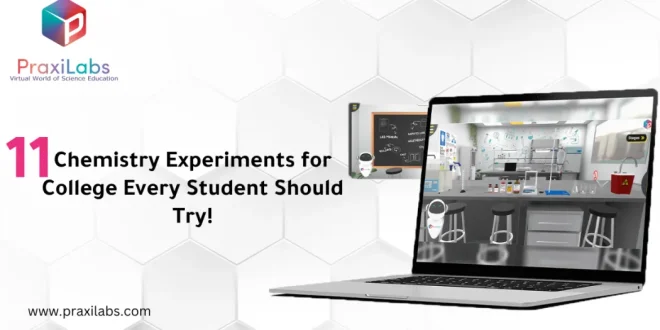Last Updated on September 17, 2025 by Muhamed Elmesery
Chemistry experiments for college are more than just a requirement for your degree—they’re a thrilling gateway to understanding the intricate workings of the universe, and exploring the principles behind everyday substances. Chemistry Lab Experiments not only deepen your knowledge but also ignite your passion for science.
In this blog post we will dive into a variety of advanced and simple chemistry experiments for college students, specifically in organic / inorganic/ analytical chemistry that can be conducted easily anytime and anywhere by using chemistry virtual labs designed to help students conduct their chemistry lab experiments easily without any risks in a safe environment and in a manner resembling a real lab.
Table of Contents
Inorganic Chemistry experiments for college students at home
Inorganic chemistry deals with the study of compounds, which does not consist of carbon-hydrogen atoms in it (inorganic compounds).
Let’s take some examples of Inorganic Chemistry experiments for college students that can be conducted at home by using virtual science labs:
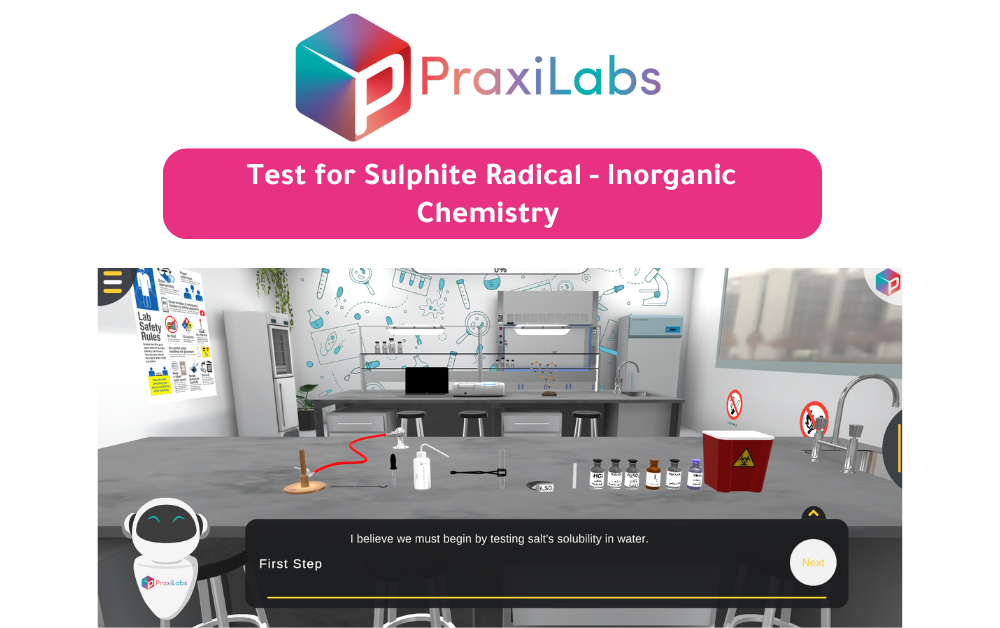
Test for Sulphite Radical
Your students will observe the reactions of an inorganic salt that has a sulphite radical with certain reagents. This is to produce characteristic colored precipitates or other easily identifiable results that are employed to identify or confirm the presence of sulphite radical in the salt.
By the end of the experiment, your students will:
- Define and differentiate between sulfite ions and other acid radicals through their chemical formulas.
- Classify inorganic salts according to their acid radicals.
- Compare sulfite ions with other first group members in terms of chemical structures, properties, and reactions.
- Identify sulfite radicals containing salts experimentally.
- Select the appropriate reagents to detect the presence of sulfite radicals.
- Balance the chemical equations of chemical reactions.
Visit Our Ever-Expanding Catalog of 3D Science Experiments Virtual Simulations and Enhance Your Students’ Learning Outcomes!
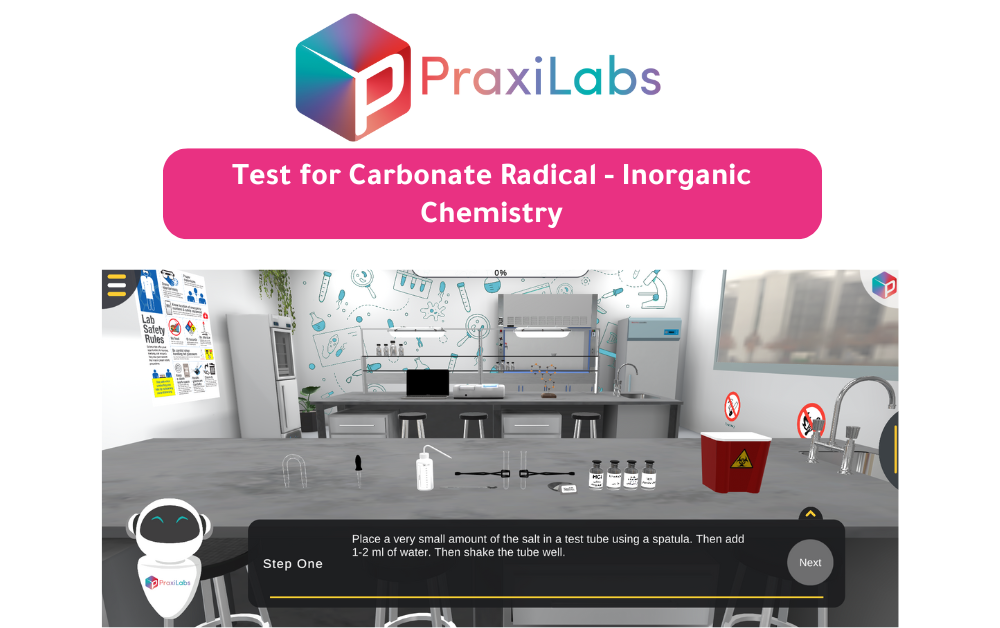
Test for Carbonate Radical Experiment
Understand how the salt is dissolved in water to test its solubility in water, then it will be tested with HCl then we will do confirmatory tests using Mercury (II) chloride and magnesium radical test reagents to confirm the presence of carbonate radical in the salt
Learning Objectives
- Define and differentiate between carbonate ions and other acid radicals through their chemical formulas.
- Classify inorganic salts according to their acid radicals.
- Compare carbonate and other first group members in terms of chemical structures, properties and reactions.
- Identify carbonate radicals containing salts experimentally and understand the test for Carbonate radical principle.
- Select the appropriate reagents to detect the presence of carbonate radical.
- Balance the chemical equations of chemical reactions.
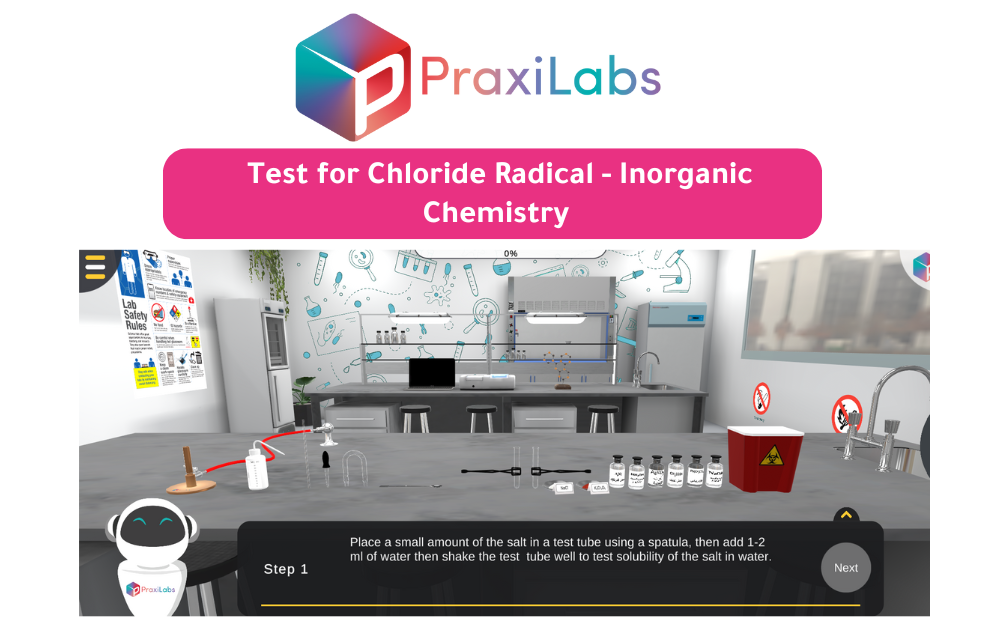
Test for Chloride Radical
In this experiment, the salt is dissolved in water to test its solubility, then it will be tested with concentrated sulfuric acid. next, confirmatory tests will be done using silver nitrate and lead acetate, followed by the chromyl chloride test to confirm the presence of chloride radical in the salt.
By the end of the experiment, your students will:
- Define and differentiate between chloride ions and other acid radicals through their chemical formulas.
- Classify inorganic salts according to their acid radicals.
- Compare chloride with other halide members in terms of chemical structures, properties, and reactions.
- Identify chloride radicals containing salts experimentally.
- Select the appropriate reagents to detect the presence of the chloride radical.
- Balance the chemical equations of chemical reactions.
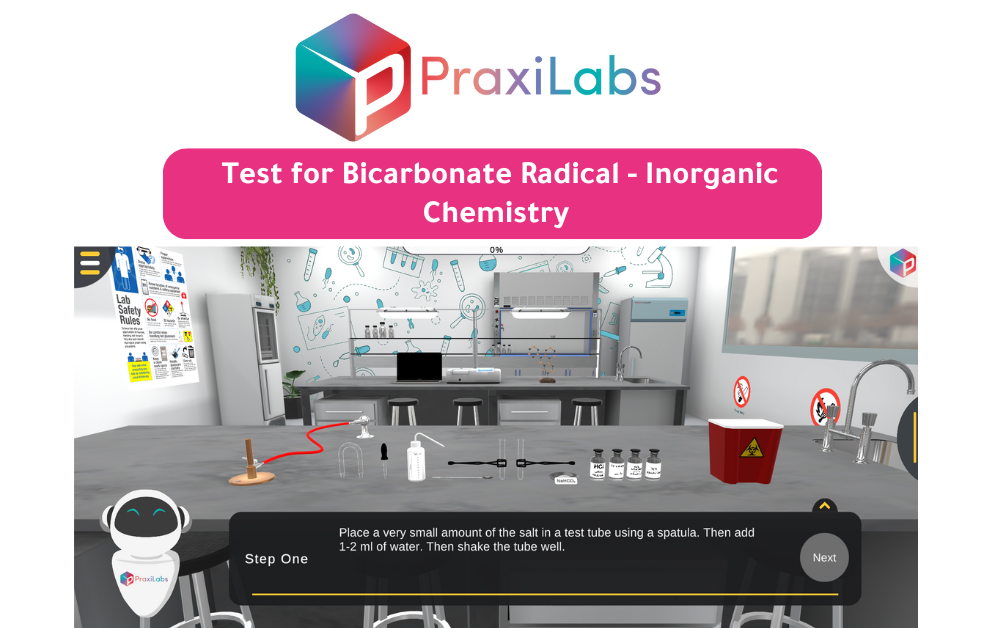
Test for Bicarbonate Radical
The bicarbonate radical is among the first group of the acidic radicals in which hydrochloric acid is used as a group reagent.
In the test for bicarbonate radical experiment, the salt is dissolved in water to test its solubility in water then it will be tested with HCl.
Afterward, we will do confirmatory tests by heating the salt solution once with mercury (II) chloride test reagent and another time with magnesium sulfate test reagent to confirm the presence of bicarbonate radical in the salt.
Learning Objectives:
- Recognize bicarbonate salts in powder form or solution.
- Apply the principles of safety measures.
- Differentiate between carbonate and bicarbonate.
- Understand various tests to identify the anion present in a given salt.
- Understand the chemical reactions and their balanced equations that take place during each test.
- Acquire the skill to perform the experiment in the real lab once they understand the different steps in the procedure.
On PraxiLabs, you can find various Chemistry virtual lab simulations accessible anytime and anywhere.
Organic Chemistry Lab Experiments for the Higher Education Classroom
The organic chemistry lab experiments for the higher education classroom focus on the study of the structure, properties, composition, reactions, and preparation of carbon-containing compounds.
Let’s take some examples of organic chemistry lab experiments for the higher education classroom by using virtual science labs:
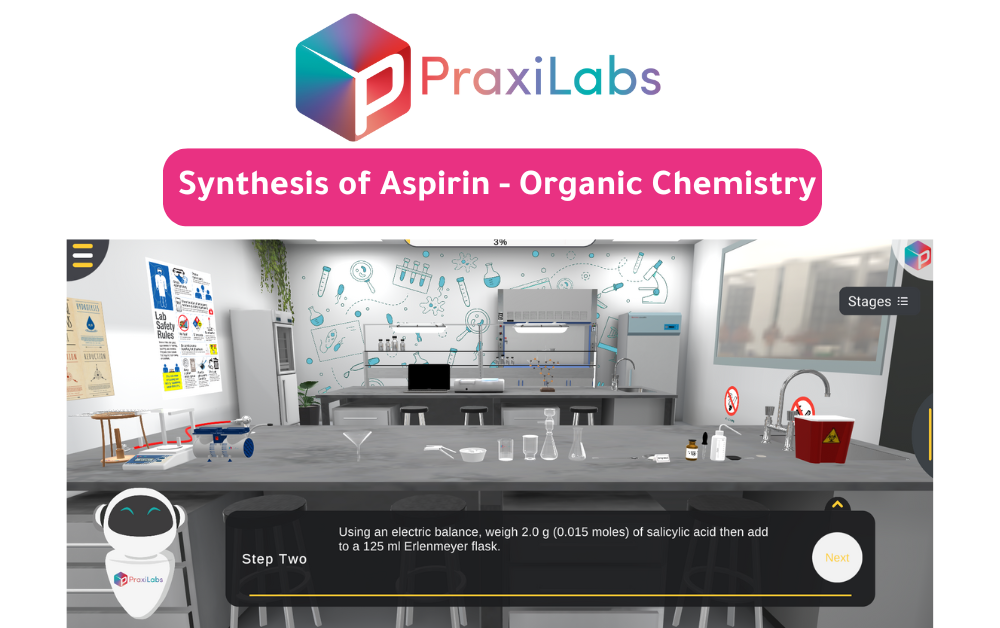
Synthesis of Aspirin
Understand how Aspirin is synthesized through the reaction of salicylic acid and acetic anhydride in the presence of phosphoric acid as a catalyst (Synthesis of Aspirin). Finally, the formed crude aspirin is purified by recrystallization using absolute ethanol, and the pure aspirin is collected by vacuum -based filtration.
Learning Objectives (ILO’s)
- Become proficient at running organic chemical reactions.
- Learn the basics of organic synthesis procedures.
- Understand the mechanism of Aspirin synthesis reaction.
- Learn the function of Aspirin synthesis reaction.
- Get trained on how the setup of the reaction is used.
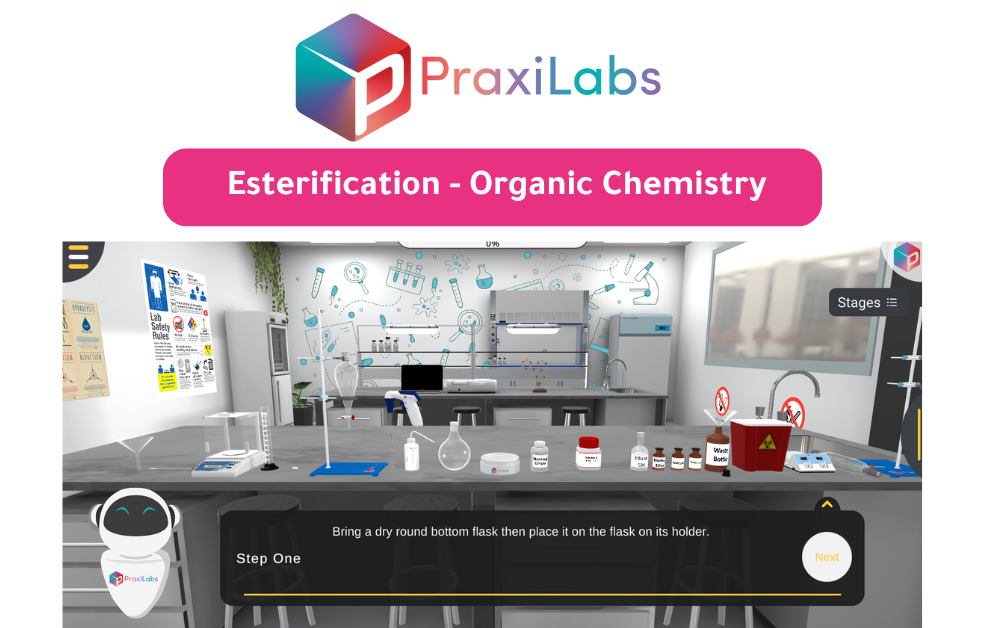
Esterification
Fischer esterification reaction is used through which esters can be prepared by refluxing a carboxylic acid with either a primary or secondary alcohol in the presence of a catalyst, commonly concentrated sulfuric acid to push the reaction forward.
By the end of the esterification experiment, your students will:
- Become proficient at running organic chemical reactions.
- Learning the basics of organic synthesis procedures.
- Understand the mechanism of the esterification reaction.
- Learn the function of the esterification reaction.
- Get trained on how the setup of the reaction is used.
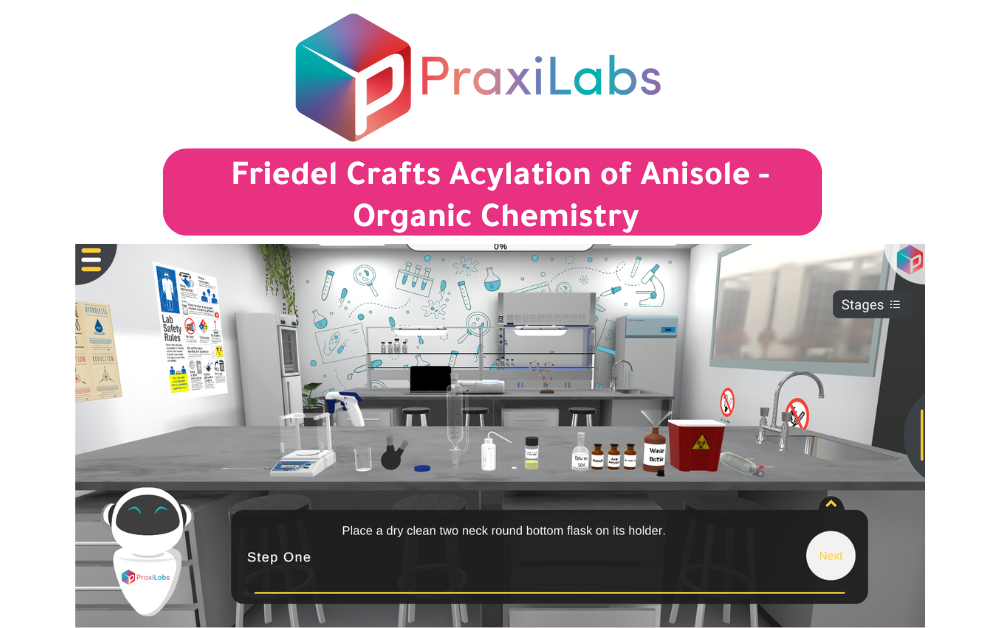
Friedel Crafts Acylation of Anisole
Learn how Acylation of anisole is carried out through Friedel Crafts reaction, where aluminum chloride is used as a catalyst. Then, the formed product is extracted using a separatory funnel. Finally, magnesium sulfate is used as a dehydrating agent for the organic layer before evaporating dichloromethane to obtain the final product.
Learning Objectives:
- Become proficient at running organic chemical reactions.
- Learn the basics of organic synthesis procedures.
- Understand the mechanism of Friedel -Crafts reaction.
- Learn the function of Friedel- Crafts reaction
- Get trained on how reflux and the setup of reaction are used
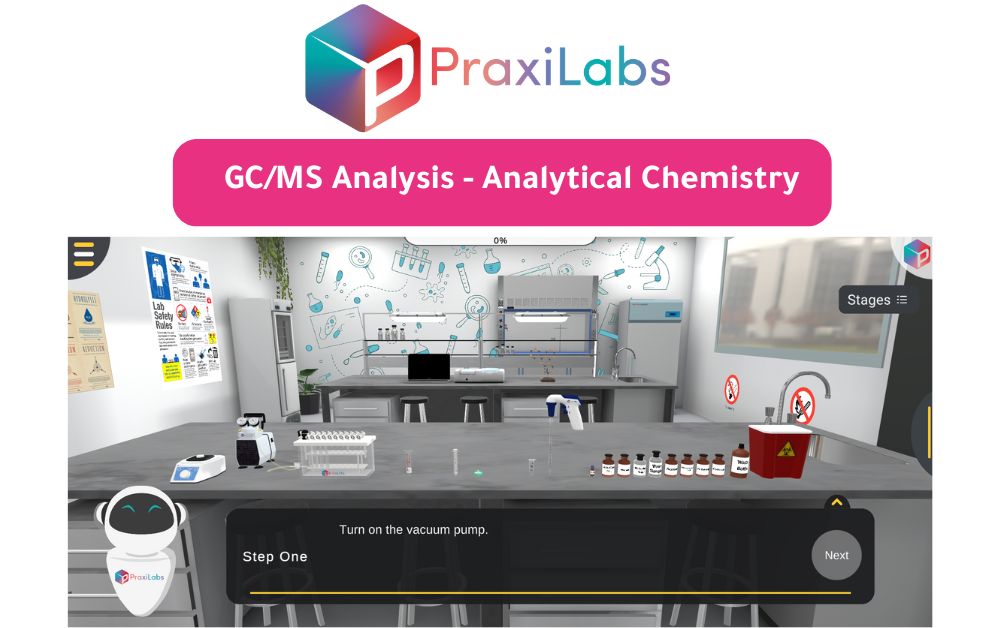
Advanced Chemistry experiments
GC/MS Analysis
GC/MS Analysis Virtual Lab is one of the best virtual labs Chemistry experiments for colleges to perform pesticide analysis in a water samples by GC-MS technique.
Understand how water sample containing a combination of different pesticides is analyzed through GC coupled MS instrument (GC MS Analysis).
Gas chromatography or GC is used to detect the number of compounds by detecting their elution time versus their relative abundance. Then each compound is further analyzed using mass spectrometry or MS to detect their chemical structure.
By the end of the experiment, your students will:
- Become proficient at basic concepts of water samples analysis.
- Learn basics of chromatographic techniques.
- Understand the mechanism of operation of GC/MS.
- Learn the functions of GC and MS in water sample analysis.
- Get trained on using the instruments and their software.
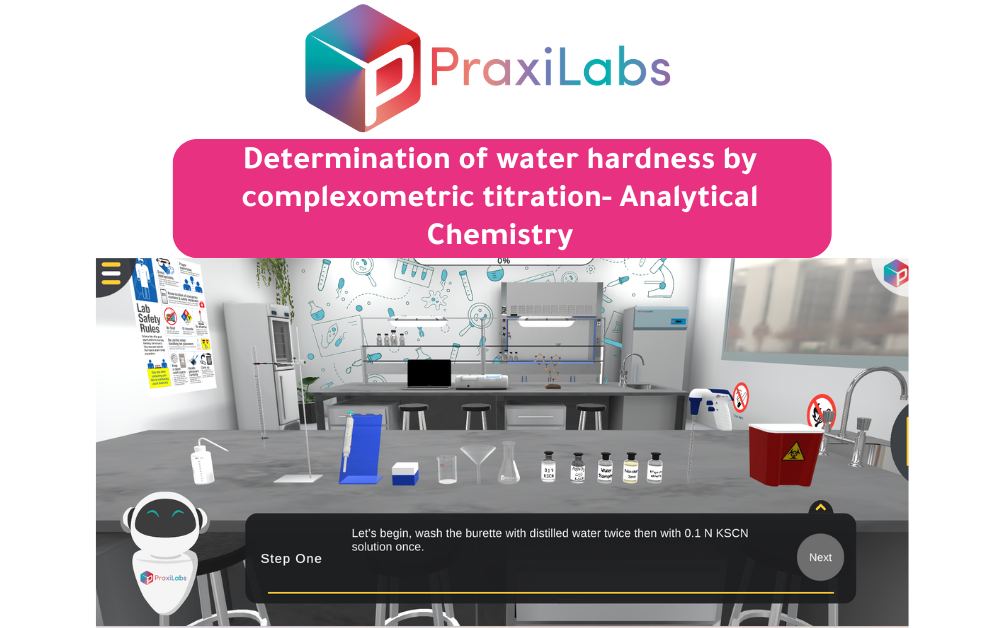
Determination of water hardness by complexometric titration
By the end of the experiment, your students will:
- Determine the concentration of the total amount of calcium and magnesium salts in water.
- Understand the drawbacks of high water hardness in our real life.
- Understand the complexation reactions.
- Understand the concept of direct titration.
Determination of concentration of chlorides in water sample (Volhard’s method)
In Volhard experiment, your students will learn how the concentration of chloride salts (analytes) e.g. NaCl is estimated using potassium thiocyanate (KSCN) as a titrant through a back titration method. Before starting the titration, an excess of silver nitrate solution (AgNO3 ) of known volume and concentration is added to the water sample (sample to be analyzed).
Learning Objectives:
- Determination of concentration of chloride salts.
- Learn about applications of Volhard’s method experiment in real life.
- Understanding the complexation reactions.
- Understanding the difference between direct and back titration
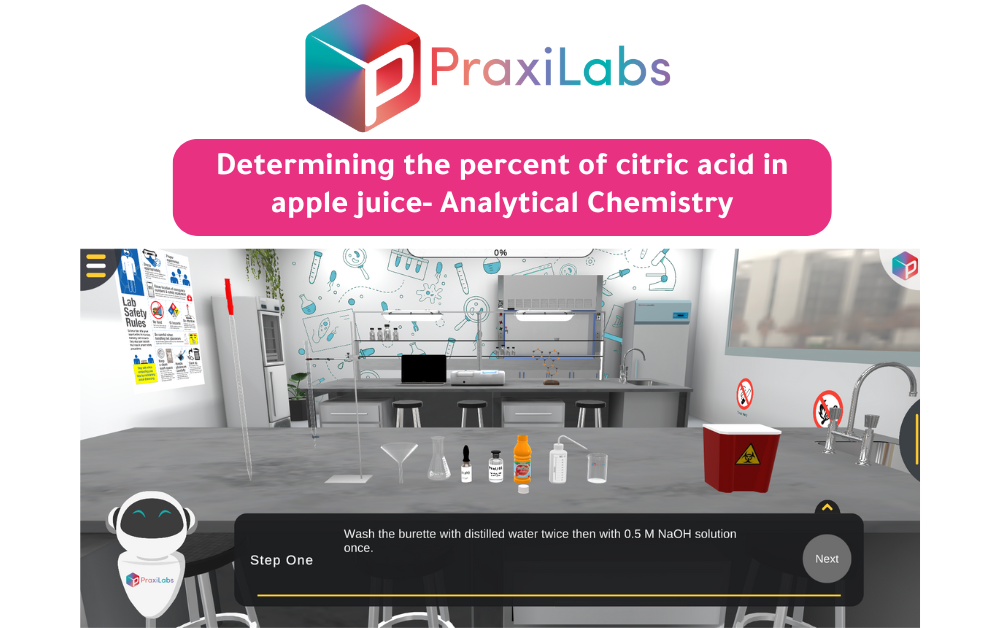
Determining the percent of citric acid in apple juice
The concentration of citric acid in apple juice can be estimated through titration of the sample with a standard solution of sodium hydroxide of known concentration. A complete neutralization reaction occurs when a specific volume of the titrant (NaOH) neutralizes the entire amount of citric acid in the sample converting it to sodium citrate salt.
By the end of the experiment, your students will:
- Identify the difference between acids and bases.
- Determine the meaning of the standard solution.
- Predict how a specific sample can be analyzed.
- Understand neutralization reactions.
- Learn the concept of acid-base titration.
- Determine the amount of citric acid in commercially available apple juice.
Now is your educational institution’s moment to shine! Try PraxiLabs Virtual Labs for chemistry today!
 PraxiLabs A virtual world of science
PraxiLabs A virtual world of science

